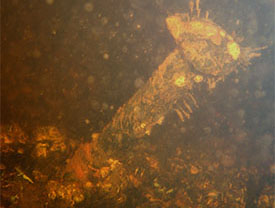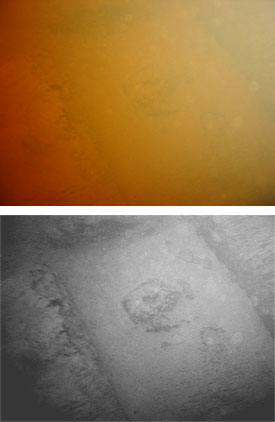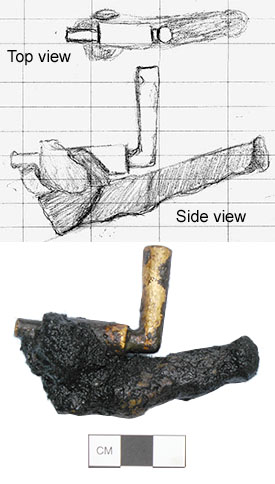ECU's 2006 Fall Field School
Project Journal
19 September 2006
By Michelle Damian

“Have you found Blackbeard’s treasure?” shouted an onlooker as he watched us dredge. While perhaps a timely question considering today was National Talk Like a Pirate Day (arrrr!), I’d guess that most underwater archaeologists are asked something similar on a pretty regular basis.

Fastener on wreck.

The before and after images above show how photo restoration software can reveal details of a notch in the keelson even from photos taken in murky water.
It’s fairly safe to say that there’s no “treasure” in the traditional sense on the Padgett vessel site. As underwater archaeologists, even if we ever would find gold and jewels we wouldn’t keep them – we record information, not salvage goods for profit. We are looking for clues to understanding the people of the past; in this case, how they built the vessel, what it might have been used for, why it wrecked or was abandoned… and a hundred other questions. The information we gain from studying each of these sites fits into the bigger picture, helping us understand more about how people lived, worked, and used watercraft in this area.
So some of our “treasure” comes in the form of the artifacts that we separate from the dredge spoil. We’ve mentioned “sifting the dredge spoil” in previous entries. All of the sand, muck, and mud sucked up off of the wreck site is spit up through a hose onto a large floating screen. One of us is responsible for separating the clam shells (and there are a lot of those) and other debris from any manmade objects – “material culture” – that might have gotten caught in the suction. We do try to leave as much as we can of that on site so that we can understand what role it plays in the wreck site as a whole… but that dredge suction is powerful! Yesterday I thought I might lose my snorkel to it.

Marble found on site.
Artifacts from the dredge spoil on this site have mostly been loose fasteners, chunks of wood, and the occasional glass bottle which has drifted on to the wreck. It’s difficult to tell at a glance if some of the objects date to the wreck itself or have drifted onto the site in later years. Some of the more intriguing artifacts are a shoe sole, some brass fixtures, and a little blue ball. Adam thinks it’s a marble; Joe thinks it’s one-half of a toy that has a blue and red ball that you crack together to make a spark. Was it a marble a sailor dropped on the vessel, rolling into a crack before he could recover it, and only found again now? Or did some local child years ago in a fit of pique take his younger brother’s toy and throw it into the river where it landed on the wreck? These are the things I wonder about when I’m on a site. Who were these people using these objects? What were they thinking about? What was the rest of their story?

Field sketch and photo of spigot found on site.
As we sift out the dredge spoil, we put the artifacts in plastic bags filled with river water (drying out an artifact that has been submerged for so long can damage the object beyond repair), marked with the date, site name, and a number. We’ll photograph the objects and perhaps draw some of them, as drawing can sometimes reveal details that might go unnoticed by the camera’s eye. Some might go on to be fully conserved, and we might return other pieces to the wreck site once we’ve completed the project. There’s our “treasure” – a rusty nail, a blue ball, a spigot-shaped piece of brass. All of it helps us to understand what has happened on the site.
Dredging and sifting has been keeping some of us occupied today, and we’ve completed the whole port side without any major dredging issues – although when the dredge hose mysteriously came unhooked, it was no surprise to see that it was Adam holding the dredge head. That was a quick fix though, and even Adam got well over an hour’s worth of dredging in! Others broke out the total station again to work on a shoreline map for Site B, while the rest of the team continued to set up the datum points for Site Recorder. We’re making progress…. If the thunderstorms crackling overhead as I type have disappeared by tomorrow, we should be in good shape.
For more information you can visit the ECU website at:
http://www.ecu.edu/maritime/index.htm
Return to Project Journal home page.

